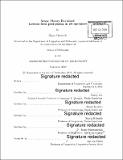| dc.contributor.advisor | Sabine Iatridou, Norvin Richards, and Roger Schwarzschild. | en_US |
| dc.contributor.author | Demirok, Ömer | en_US |
| dc.contributor.other | Massachusetts Institute of Technology. Department of Linguistics and Philosophy. | en_US |
| dc.date.accessioned | 2020-03-09T18:53:40Z | |
| dc.date.available | 2020-03-09T18:53:40Z | |
| dc.date.copyright | 2019 | en_US |
| dc.date.issued | 2019 | en_US |
| dc.identifier.uri | https://hdl.handle.net/1721.1/124104 | |
| dc.description | Thesis: Ph. D. in Linguistics, Massachusetts Institute of Technology, Department of Linguistics and Philosophy, 2019 | en_US |
| dc.description | Cataloged from PDF version of thesis. | en_US |
| dc.description | Includes bibliographical references (pages 187-195). | en_US |
| dc.description.abstract | It is widely assumed that both the movement-based theory of scope and the scope-based theory of intensionality fall short in the face of empirical challenges like 'exceptional' scope out of extraction islands and the possibility of transparent/de re construals for DPs inside extraction islands. The standard response to these challenges consists in assuming that grammar makes available in-situ methods of scope-taking in addition to movement- (e.g. pointwise composition (Hamblin, 1973; Kratzer and Shimoyama, 2002; Cable, 2010), choice functions (Reinhart, 1997, 1998)) and adopting a richer representation of intensionality (e.g. in-situ binding of world/situation-denoting pronouns (Percus, 2000)). This thesis argues that a closer study of pied-piping in wh-questions reveals the true power of already-existing tools in grammar. Building on the important insight that more complex scope-takers can be recursively built (Dayal, 1994; Charlow, 2017), I advance the idea that grammar makes crucial use of pied-piping to generate meanings that would otherwise be unavailable. I argue that with pied-piping in its toolbox, grammar may not need in-situ methods of scope-taking and in-situ methods of assigning DPs a transparent/de re construal. | en_US |
| dc.description.statementofresponsibility | by Ömer Demirok. | en_US |
| dc.format.extent | 195 pages | en_US |
| dc.language.iso | eng | en_US |
| dc.publisher | Massachusetts Institute of Technology | en_US |
| dc.rights | MIT theses are protected by copyright. They may be viewed, downloaded, or printed from this source but further reproduction or distribution in any format is prohibited without written permission. | en_US |
| dc.rights.uri | http://dspace.mit.edu/handle/1721.1/7582 | en_US |
| dc.subject | Linguistics and Philosophy. | en_US |
| dc.title | Scope theory revisited : lessons from pied-piping in wh-questions | en_US |
| dc.title.alternative | Lessons from pied-piping in wh-questions | en_US |
| dc.type | Thesis | en_US |
| dc.description.degree | Ph. D. in Linguistics | en_US |
| dc.contributor.department | Massachusetts Institute of Technology. Department of Linguistics and Philosophy | en_US |
| dc.identifier.oclc | 1142635477 | en_US |
| dc.description.collection | Ph.D.inLinguistics Massachusetts Institute of Technology, Department of Linguistics and Philosophy | en_US |
| dspace.imported | 2020-03-09T18:53:40Z | en_US |
| mit.thesis.degree | Doctoral | en_US |
| mit.thesis.department | Ling | en_US |
